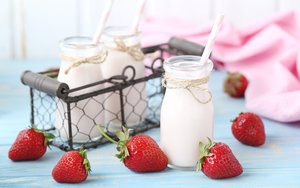beverages
Yogurt Drinks: Still Relatively Small, But Growing Fast
- by Karlene Lukovitz @KLmarketdaily, October 18, 2016

Yogurt drinks are helping to keep the overall yogurt category growing at a healthy pace, even as the explosive growth spurred by the advent of Greek has been slowing.
Between 2011 and 2016, sales of yogurt drinks (including fruit varieties, smoothies, kefir, lassi et al.) grew by 62%, to $893 million, according to Mintel — pretty impressive, even for a relatively new subcategory with lots of room for growth.
The researcher projects that sales of drinkable yogurt will jump 11% this year -- the second year of double-digit growth.
That said, the liquid format still represents a small share in comparison with spoonable yogurt, which will reach an estimated $8.2 billion this year and represents about 90% of total yogurt sales. Spoonable yogurt is projected to reach $10 billion by 2021.
advertisement
advertisement
The total category will grow by a more-than-respectable 3% this year to $9.1 billion, and will reach $11.4 billion by 2021.
Fully 66% of U.S. adults now buy spoonable yogurt, and a sizable 30% now buy yogurt drinks, according to Mintel’s newly released report on the category.
“As the boom times ushered in by the novelty of Greek offerings fade, category players are stepping up flavor and format innovation” in the category, sums up Beth Bloom, senior food and drink analyst at the firm. Particularly promoted for breakfast and snacking, the still-small yogurt drinks segment represents an opportunity to further leverage yogurt’s “convenient health” positioning, she notes.
Furthermore, “as adoption of the yogurt drinks segment grows, so does innovation,” Bloom says, pointing out that it’s one of the few food and drink categories brand-new product launches are outpacing “simple variations on form.”
Mintel reports that 93% of U.S. consumers eat yogurt or drink yogurt beverages for breakfast sometimes.
However, although yogurt is often being cited as the main culprit in declining cereal sales, cereal remains the breakfast king. Sixty-five percent of U.S. consumers buy cereal for breakfast, 55% buy bread, 48% buy breakfast meals, and 45% buy yogurt.
Yogurt is gaining ground as a snack. Again, 93% sometimes consume it as a snack. And 84% consume it as a morning or afternoon snack, up from 78% in 2014.
Snacking is a “huge” opportunity for the category, which is introducing new formats that include “savory and satiating” varieties, according to Bloom.
Well-being and nutritional reasons continue to drive yogurt consumption, with 43% saying they buy it for digestive health, and 37% for its calcium content (47% among female yogurt consumers).
Among consumers overall, nearly a quarter (23%) say they buy yogurt products to support weight loss, and just 16% buy whole-fat varieties.
However, three-month data ending in May 2016 shows that about 22% of Millennials are buying whole-fat varieties. Those are seeing strong growth in natural channels, whereas sales of non-fat options are struggling, “pointing to a growing acceptance of fat in food,” says Bloom.
Appealing to consumers’ ever-increasing interest in functional foods and beverages is one way that yogurt marketers can differentiate their products, she adds.




